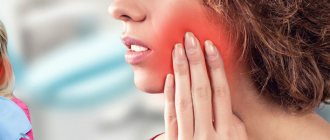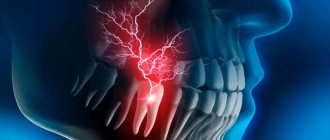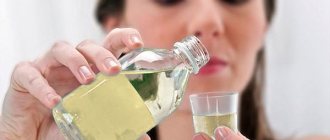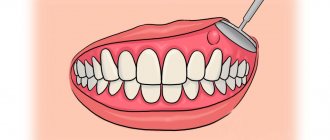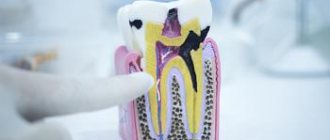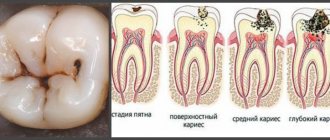What to do if your tooth hurts
Medicines
Folk remedies
Causes
If children have toothache
Toothache can occur unexpectedly and take you by surprise in the most inopportune place. Let's look at how to relieve pain before going to the dentist in this article.
What not to do if you have a toothache
The goal of first aid for dental pain is to alleviate suffering and create tolerable conditions for the patient before going to the dentist. And it is advisable to do this without serious health complications for the sake of five-minute relief. Therefore, it is worth knowing first of all what not to do.
Do not apply heat. If you suffer from acute toothache, it is not recommended to heat either the tooth itself or the cheek. Severe toothache indicates the presence of an inflammatory or infectious process. By applying warm compresses or using other heating methods, you stimulate blood flow to the pathological area. Instead of one diseased tooth, you can get a complication affecting the entire dentition.
If a tooth hurts, it is much more effective to replace warm compresses with briefly applied ice;
Use medications carefully. You cannot blindly believe everything that is written on the Internet. Severe toothache can be effectively relieved or alleviated only in a dental office. All other methods give only an insignificant short-term effect; you should not expect a miraculous cure from them. Do not inject painkillers into the gums yourself, and do not use medications not intended for this purpose to relieve toothache. For example, an aspirin tablet applied to a disturbing tooth can cause severe burns to the mucous membrane, but will not bring relief;
Bed rest is not for you. If you are taken by surprise by an acute toothache, it is better to resist it on your feet or while sitting. The half-sitting position is the very compromise that will allow you to more comfortably endure an unpleasant and exhausting situation and will not cause even more harm to the aching tooth. The fact is that when a person is in a horizontal position, the blood flow to the diseased tooth increases. Increased pressure is created around the already irritated nerve endings and severe toothache becomes simply unbearable. If an acute toothache catches you at night, place the pillows higher, lean back on them and try to take a nap in this position;
Hot rinses and folk remedies. Most ways to relieve tooth pain are based on traditional methods of treatment and pain relief. And the vast majority of recipes advise using hot rinses. You can't do this! But if you use these same herbal decoctions warm, the effect can be very positive, in extreme cases, harmless.
What is anesthesia?
The procedure for injecting special drugs aimed at eliminating local sensitivity is called anesthesia. The active substance of the anesthetic blocks the conduction of impulses from nerve endings to the brain, preventing the occurrence of pain in response to manipulations. After the anesthetic wears off, sensitivity is completely restored.
Today in dentistry there are several types of local anesthesia. The most commonly used anesthesia is an injection into the area of one tooth. Other methods are aimed at “switching off” the nerves of several teeth at once.
The anesthesia procedure allows you to avoid discomfort during dental procedures, which is why anesthesia is used everywhere during the treatment and extraction of teeth.
What to do if your tooth hurts
First aid for a toothache begins with identifying the causes of the discomfort and eliminating irritating factors. Toothache can be caused by various irritants:
- Hot or cold food and drinks;
- Cold air;
- Sweet, sour, salty foods and drinks;
- Pressure drop;
- Head position;
- By pressure or other influence;
- Food getting into the carious cavity;
- Other mechanical effects on the tooth.
As soon as it becomes clear why the tooth hurts at a particular moment, it is necessary to stop the irritating influence. After this, consult a doctor for help. If the appointment is postponed for a long time, then it is worth taking painkillers.
Diagnostics
Diagnosis of pulpitis takes place in several stages. The first is an examination of the oral cavity by a dentist. The patient's complaints about acute pain, the presence of injury or a carious cavity are taken into account. All this points to pulpitis. But it is impossible to determine the acute and chronic forms of the disease by one visual examination.
To determine the stage and type of pathology, the patient is prescribed an examination:
- X-ray.
- EDI or electroodontodiagnosis. This method allows us to identify the reaction of the pulp to the influence of electric current.
- Rheodentography. It is carried out to assess the blood supply to the dental pulp.
- Thermal test.
To make an accurate diagnosis, differential diagnosis of acute pulpitis is important. This is important so as not to confuse it with other diseases that have similar manifestations.
Medicines for toothache
There are many painkillers in pharmacies that are quite effective in helping when a tooth hurts. However, when choosing medications without a prescription and doctor’s recommendations, it is worth remembering that each medicine has a number of contraindications and side effects, so you need to carefully read the instructions, and, if possible, check with pharmacists and pharmacists for information.
The following medications are used to relieve toothache:
| Analgin; | Indomethacin; | Piroxicam; |
| Denebol; | Ketanov; | Solpadeine; |
| Diclofenac; | Ketoprofen; | Tempalgin. |
| Ibuprofen; | Naproxen; |
For local anesthesia and gum disease, Kalgel, Dentinox, Cholisal, Kamistad and Mundizal are suitable. You can also use herbal rinses. They have a calming and antiseptic effect.
Reasons for the lack of effect of anesthesia
- Individual features of anatomy. The effect of the local anesthetic is ensured by its injection into a specific location near the nerves. However, there are people who have a non-standard structure and arrangement of nerves. In such situations, additional injections of anesthetic solution are required in other areas.
- Local inflammatory process. In the presence of infectious inflammation in the tissues, the pH level decreases, which indicates an increase in the acidity of the environment. Under such conditions, the chemical structure of anesthetics is destroyed and their effect is neutralized. There are several solutions to this problem: preliminary therapy with antibacterial drugs or the use of alternative methods of pain relief that do not affect the area of inflammation (Gow-Gates anesthesia, intraosseous anesthesia, etc.).
- Ehlers-Danlos syndrome. This is a genetic disease that affects the condition of the skin, bone tissue and muscles. With this pathology, conventional anesthesia is not effective, and it is necessary to resort to the use of stronger drugs. In some cases, for high-quality pain relief, several injections are required at once.
- Psychological state of the patient. With dental phobia (panic fear of dental treatment), the production of anxiety hormones that interfere with the action of anesthetics increases. People with this condition are advised to take sedatives before visiting the dentist.
- Red hair color. It is known that red hair is a consequence of a mutation in the melanocortin-1 gene, a change in which also reduces the effectiveness of local anesthesia.
- Poor quality anesthetic. If the storage rules for the drug are not followed and its expiration date expires, you may not expect any effect from the administration of the anesthetic. Therefore, you should be responsible when choosing a doctor and a clinic where treatment will be carried out.
- Insufficient amount of administered drug. If the dosage is incorrectly selected, the anesthetic will not be able to work effectively.
- Wrong choice of drug for pain relief. The anesthetic should be selected by the dentist depending on the method of anesthesia and the desired result.
- Violation of the integrity of the mucous membrane at the site of injection of the anesthetic. The solution will simply flow out of the tissue without having the desired effect. This can happen if you select an injection needle incorrectly, which will injure the mucous membrane, forming a wide channel behind it.
If pain relief is repeatedly unsuccessful during treatment or tooth extraction, the dentist will be able to determine the cause of the problem and select an alternative method of anesthesia.
Folk remedies for toothache relief
The most popular folk remedies are also based on rinsing the mouth with a decoction of various herbs, as well as applying various non-heating compresses to the sore tooth.
The most effective rinses are:
| Sage; |
| Oregano; |
| Oak bark; |
| Chamomile decoction; |
| Calendula; |
| A solution of soda, salt and iodine. |
Pain in the teeth is well relieved by compresses or acupressure on the sore tooth. To do this, use tampons or cotton pads soaked in a medicinal solution or containing a medicinal substance. This may serve as:
- Propolis;
- Essential oils;
- Alcohol or strong alcohol;
- Garlic or onion-garlic mixture with salt.
Do not forget about the simplest and surest way to temporarily numb the tooth that is bothering you. Just take an ice cube out of the freezer and apply it briefly to the sore area. The cold freezes and stops all processes, so the pain will subside for a while. Do not apply cold for a long time, as it can chill the nerve endings.
Essential oils.
Since ancient times, the properties of essential oils have been used; their use is called aromatherapy. Indeed, they obtained from a variety of plants have a bactericidal and anti-inflammatory effect. A large number of them can have an analgesic effect. Therefore, the use of essential oils to relieve toothache has become widespread. Oils can be used to massage the gums, or soak cotton wool in them and place them on the tooth, or even make a compress on the cheek. Let's look at how to relieve toothache using folk remedies.
using aromatic oils:
- Once upon a time, unopened and dried carnation flowers were difficult to obtain. This is not only a well-known spice - this plant has many amazing properties. For example, the oil obtained from the petals of this plant has a strong effect. A cotton wool soaked in it and placed in the “hollow” of a diseased tooth is quite effective. However, it should be noted that there may be an allergic reaction to it.
- One of the most powerful natural analgesics is cajuput oil. It works effectively when applying compresses. This oil has an antiseptic effect and relieves swelling. The method of application is simple - apply 4-5 drops of essential oil to a damp bandage and apply it as a compress on the sore side to the cheek.
- Peppermint oil works in a similar way, only you need to moisten a cotton swab with it, which is applied to the tooth, and then replace it until the pain subsides.
- Various mixtures of oils can also be used. So 1 drop of clove oil with 2 drops of mint and 2 lavender, dissolved in a teaspoon of almond oil is also very effective. To apply, use cotton wool, which is moistened with the mixture and applied to the tooth.
Acute toothache
It appears very unexpectedly and is rapidly gaining strength. Pain in the teeth can be so severe that a person may lose consciousness for a while.
Severe toothache can occur when eating, while talking, while drinking a cup of coffee, when clenching your jaw, turning or tilting your head, climbing stairs, and even just while breathing. During each of these actions, the sensitive tooth will encounter irritants and react with severe pain:
- For hot food or water;
- To cold air;
- To change pressure and increase blood circulation.
In this case, toothache can be short-term, occur only in the presence of irritating factors and subside after their removal, incessant, or it can appear and disappear.
In any case, toothache is a reason to immediately consult a doctor. Without delay and expectation of serious complications.
Consumer Reviews
Bubble_gum (irecommend.ru):
“Hello to everyone who stopped by! As you already understand, today I will share my experience of using Asepta Active mouth rinse. Problems with my gums have been tormenting me for a long time - they constantly bleed and become inflamed. One of the reasons is tartar, which I recently went to remove. You can read about how it was and whether you need it here.
After treatment, the doctor prescribed this mouthwash to me. They didn’t tell me how long I needed to use it, but I already understood that it was a week, and then a break. Otherwise, as the dentist said, the microflora of the oral cavity can be disrupted.
I bought Asepta Active mouthwash in a regular pharmacy for 138 rubles, in the clinic where I had my teeth treated it costs 180 rubles. I bought it in the summer, now the price, for example, on the website is 174 rubles. A little more expensive at a regular pharmacy.
I purchased Asepta Active because... it is aimed at treating gums. Simply "Asepta" is intended for freshness of the oral cavity.
The set includes a measuring cup.
Color: transparent, due to the design of the packaging it seems blue.
Taste: Mint.
When using it, it stings and burns a little. The tongue becomes numb if the mouthwash is not diluted with water.
Consumption: the cost-effectiveness of the product naturally depends on how often you use it and in what quantity.
I use it according to the instructions - I dilute half a measuring cup with water, otherwise it makes my mouth ache, but not too much and not scary, in principle. I use this rinse 1-2 times a day, but not daily. One such bottle lasted me a little more than 1 month. Very economical. But let me emphasize once again: the consumption depends on your personal volume of use of the product.
What effect are we promised from using this mouthwash?
Mouthwash "Asepta®":
- has a pronounced antibacterial effect;
- relieves inflammation and bleeding of gums;
- prevents the formation of dental plaque;
- freshens breath.
I have been using this rinse for more than 4 months, intermittently, and I can say that there is a result. Of course, not only does it solve my problems, I also use Asept toothpaste, and, of course, the correct movements with the toothbrush. And in case of severe inflammation, I save myself with dental gel (this and this)
Action:
- The gums have become less bleeding, although this is the merit not only of this rinse, but of other products as well.
- After use, you feel fresh for a long time.
- Dental plaque began to form less.
Compound:
Active substances:
- Benzydamine hydrochloride Chlorhexidine bigluconate Menthol 0.15% 0.05% 0.01%
- Excipients:
- Water, xylitol, glycerin, polysorbate 20, food mint flavoring.
I didn’t look into the ingredients here, the main thing is that the rinse aid helps, and that’s good. I don’t take it internally.
Side effects may occur when using this mouthwash:
When applied topically, the components do not have a systemic effect.
Allergic reactions, dry mouth, numbness, burning sensation in the mouth, and drowsiness may occur.
Apart from numbness of my tongue, I had nothing else. (And then, only for the first time, when I didn’t read the instructions.) Therefore, I dilute the rinse aid with water 1:1.
Now I always buy this rinse aid, I am satisfied with it. I give it 5*.
I recommend purchasing Asepta Active mouth rinse if you have found your corresponding symptoms in the Indications for Use. .
Thank you for your attention.
And remember, everything is individual, I described my experience of using it and my impressions of the product.”
Dewilka(irecommend.ru):
“The best rinse for problem gums + TIPS for use!!! LOTS OF PHOTOS + how to make a simple but effective mouthwash!!!
I have problem gums. Exacerbation of periodontitis occurs periodically. I used to think that only those over 50 suffer from this disease... how wrong I was. And recently I got braces, and decided from the very beginning to maintain the health of my gums, since many people experience worsening of various gum diseases when wearing braces.
My periodontist recommended the Asepta rinse as the most effective rinse that really HELPS.
A 150 ml bottle cost me 182 rubles. I bought it at a pharmacy kiosk at a local city dental clinic. It is not so easy to find in the city, and it is practically never found in local pharmacies.
This rinse is intended for use in infectious and inflammatory diseases of the oral cavity. This means that you can’t use it just like that, for example, to freshen your breath. Otherwise, you can harm yourself. I'll explain why below.
The composition includes a solution of chlorhexidine 0.05%, which is a strong and effective broad-spectrum antiseptic. This means that with long-term use (more than 1 week), you can spoil the microflora of your mouth, and even develop oral thrush! So, don't overuse it!
It also contains benzydamine. Apparently, it is he who causes severe numbness of the tongue. If I had read the instructions at the beginning, I would not have suffered after the first use. I felt my tongue numb for several hours. In general, read the instructions every time you use something for the first time! It is necessary!
For those too lazy to read the instructions, here's a photo:
It also contains xylitol, which has a powerful anti-caries effect, which is good news.
Glycerin is also present in the composition. To retain moisture.
There is polysorbate - it has a good effect on the gums and has an astringent effect. But for me, it would be better if they added a decoction of oak bark, it would be more helpful.
What does the mouthwash taste like??? The most interesting thing is that the food flavoring “mint” is in the LAST place in the composition. I don’t know how much of this flavor there actually is in the mouthwash; it tastes like you’re rinsing your mouth with a simple chlorhexidine solution. That’s why it’s the last place in the lineup, because there’s the bare minimum of it there. In general, the taste is disgusting.
God, what am I happy about... I have never seen a rinse with dyes!))))
One bottle of mouthwash lasted for 7 days.
RESULT OF WEEKLY USE:
- the condition of the gums has improved significantly;
- they stopped bleeding and hurting;
- gums have become stronger (according to internal sensations)
Now I don't worry about them Smile
As a preventive measure, I plan to buy it in the future. The product is excellent. It helps a lot!
I recommend it to anyone with bad gums!
Tip: if you are concerned about the feeling of numbness in your mouth, simply dilute the product with water. I fill half a measuring cup with rinse aid and then add water. approximately 1:1. This does not affect the effectiveness, but is much easier to tolerate.
And finally, I want to share with you a simple recipe for a homemade mouthwash. It can be easily prepared at home. You can use filtered water or any herbal decoction as a base. A solution of chamomile or oak bark is best. You can also include various essential oils that can only be found in pharmacies. The best option is tea tree oil. It has excellent bactericidal, wound-healing, antiviral, immunomodeling, and disinfectant properties. Good breath freshener. Instead of essential oil, you can add 1 tablespoon of honey. Mix everything thoroughly. You can rinse both morning and evening. Store the remaining solution in the refrigerator. Dilute a little with warm boiled water.
Enjoy it to your health!”
Sources:
- https://cyberleninka.ru/article/v/kompleksnoe-lechenie-hronicheskogo-retsidiviruyuschego-aftoznogo-stomatita-s-ispolzovaniem-preparatov-lineyki-asepta Balashova L.V., Barakov M.A., Khaikin M.B. The use of "Asept" in the treatment of periodontal tissue diseases, bulletin of the medical institute "REAVIZ"
- The use of drugs from the Asepta line in the complex treatment of inflammatory periodontal diseases (N.V. Berezina E.N. Silantyeva S.M. Krivonos, Kazan State Medical Academy. Kazan.) N.V. BEREZINA, E.N. SILANTIEVA, S.M. KRIVONOS Kazan State Medical Academy
- https://cyberleninka.ru/article/n/sovremennye-lechebno-profilakticheskie-sredstva-dlya-individualnoy-gigieny-polosti-rta Silantieva E.N., Berezina N.V., Krivonos S.M. Complex treatment of chronic recurrent aphthous stomatitis using drugs from the Asept line, Practical Medicine journal
Muffled pain in teeth
This is a toothache that a person is used to putting up with and has adapted to live with. It is not as severe as an acute toothache, but it is unpleasant and poisons life. It can be permanent or periodic, occur with a certain pattern, in response to known stimuli, or on its own.
The cause of muted pain is various diseases of the oral cavity. Even the first sensations of pain are a reason to consult a doctor. Most serious illnesses begin with a completely tolerable pain reaction. But if you don’t visit the dentist in time, you can get pulpitis instead of regular caries, and instead of bleeding gums, you can lose a tooth. To prevent this from happening, you don’t have to endure it when your tooth hurts; you need to immediately make an appointment with a doctor.
Recommendations before visiting the dentist:
- The night before your appointment, drink lemon balm or chamomile tea before bed. These natural remedies have excellent calming effects.
- If you have constant strong feelings, before each dentist appointment, it is recommended to take a course of light sedatives a week before visiting the doctor. For example, “Afobazol” and “Tenoten”, they calm the nervous system, improving well-being and relieving anxiety before dental surgery. Drugs such as valerian and motherwort are best taken in tablets: tinctures are alcohol-based, which impairs the quality of pain relief.
- For the same reason, you should not drink alcoholic beverages at least 24 hours before your dentist appointment. Alcohol is eliminated from the body within 72 hours, but the products of its metabolism remain in the body for another week. To speed up the cleansing of the body from toxic substances, it is recommended to take sorbent preparations.
- Get a good night's sleep and eat before your appointment. This way you will save yourself from additional stress, and, consequently, from unnecessary problems during dental procedures.
- Be sure to tell your dentist about any medical conditions you have and the medications you are taking! This will help the doctor choose the right method of pain relief and anesthetic. In addition, taking certain medications can greatly reduce the quality of pain relief.
The main recommendation would be a careful approach to choosing a dental clinic and doctor. After all, a competent dentist, even if difficulties arise with administering anesthesia, will be able to find the right way out of the current situation.
Possible causes of toothache
Caries at different stages can cause pain in the teeth. As a result of poor oral hygiene, tartar forms on the teeth, and as a result, caries develops. Gradually, the tooth enamel will be destroyed, and the internal sensitive tissues of the tooth will begin to be affected. In the first stages of caries development, the tooth may react painfully to hot and cold. When the nerve is already inflamed, toothache may occur as a result of food or water coming into contact with it. Self-medication will not help here: the cause of pain can only be eliminated in a doctor’s office;
abscess or gumboil. Purulent deposits form directly in the gums. In this case, the pain in the teeth is quite sharp and throbbing. There is severe swelling in the oral cavity; in particularly severe cases, the entire cheek may become swollen;
Pulpitis is a logical continuation of advanced caries, which causes severe pain in the teeth. When a tooth hurts due to pulpitis, unexpected severe attacks can be experienced at any time of the day or night, with irradiation into the ear or temple;
Mechanical damage . Tooth trauma, chipped enamel, damage to the crown of the tooth - all this will inevitably lead to pain. If the enamel is damaged, but the nerve remains intact, then pain may not occur immediately, but if you do not consult a doctor in a timely manner, an inflammatory process of the pulp may begin;
Various gum diseases - periodontitis, periodontitis, exposure of the necks of teeth. All these diseases often begin with bleeding gums and have very serious consequences, including tooth loss. Therefore, they definitely require treatment at the dentist’s office.
Tincture of calamus and propolis.
Tinctures must be prepared in advance and not mixed before use. The first tincture - in a ratio of 1 to 5, pour vodka over the root of calamus and leave to infuse for 10 days. The second tincture is also based on vodka. You need 15 grams of propolis (which needs to be crushed) per 100 grams of vodka. It also infuses for 10 days. Both tinctures must be stored in a cool, dark place.
Tinctures are used as follows: take one tablespoon of calamus (tincture) and half a tablespoon of propolis (tincture), stir and rinse your mouth with the resulting mixture for 10 minutes. After rinsing, the mixture must be spat out.
Tooth pain in children
An adult can still endure toothache. But when a child has a toothache, it is no less painful for a parent, since it can be very difficult to help in such a situation. Pain in the teeth, or more precisely in the gums, begins in the first year of life, when the baby begins to teethe. In this case, there is no need to urgently run to the dentist for help. A scheduled visit to a specialist as part of a scheduled medical examination is sufficient.
Special teething toys with a cooling effect, toothpastes and silicone brushes for babies, as well as local painkillers will help relieve your baby’s toothache during this period. The most popular and safest for the health of children are Kalgel and Cholisal.
If the problem is not teething, and the baby is worried about something else, for example, problems with the gums or oral mucosa, this is a reason to urgently consult a doctor. Even at such an early age, a dentist can diagnose candida or gingivitis. Proper oral hygiene and timely local treatment will help quickly solve the problem.
Your baby may experience toothache when baby teeth emerge. The very first serious disease is bottle caries. An incorrect diet and prolonged use of a bottle can lead to complete loss of the front baby teeth, so regular visits to the dentist are mandatory from an early age.
After bottle caries, the most common caries of baby teeth can develop. It is very difficult to treat such teeth, since fillings do not adhere well to small teeth. It is much easier and more effective to prevent the development of the disease. Today, pediatric dentistry offers many ways to preserve baby teeth.
Tested methods:
- For toothache. Consists of two ingredients. The first tincture - in a ratio of 1 to 5, pour vodka over the root of calamus and leave to infuse for 10 days. The second tincture is 15 grams of propolis (which needs to be crushed) per 100 grams of vodka. It also infuses for 10 days. Both tinctures must be stored in a cool, dark place. Usage – take one tablespoon of calamus (tincture) and half a tablespoon of propolis (tincture), mix and rinse your mouth with the resulting mixture for 10 minutes. After rinsing, the mixture must be spat out.
- One of the most terrible types of toothache is crown pain. It is impossible to solve the problem by direct influence - there is no access, and time drags on slowly. The recipe for the solution is simple - you need to mix a teaspoon of soda and extremely finely ground table salt, and brush your teeth with this powder 3 times a day. However, it is necessary to rinse your mouth after brushing only after 10 minutes.
Back
